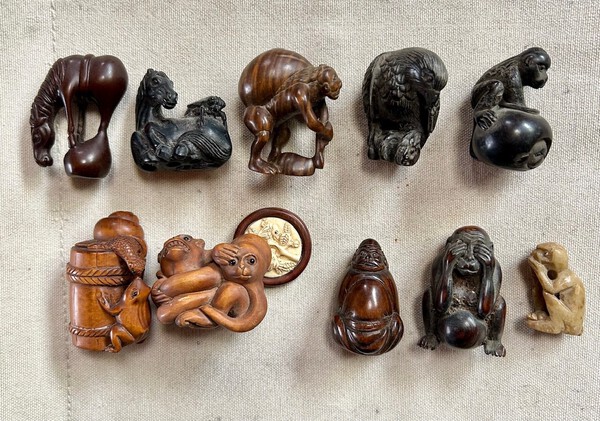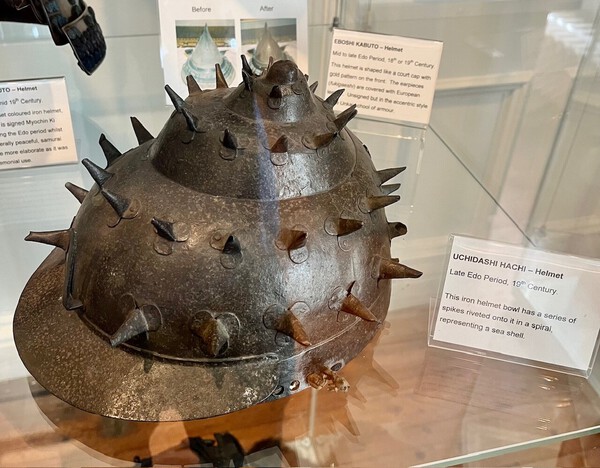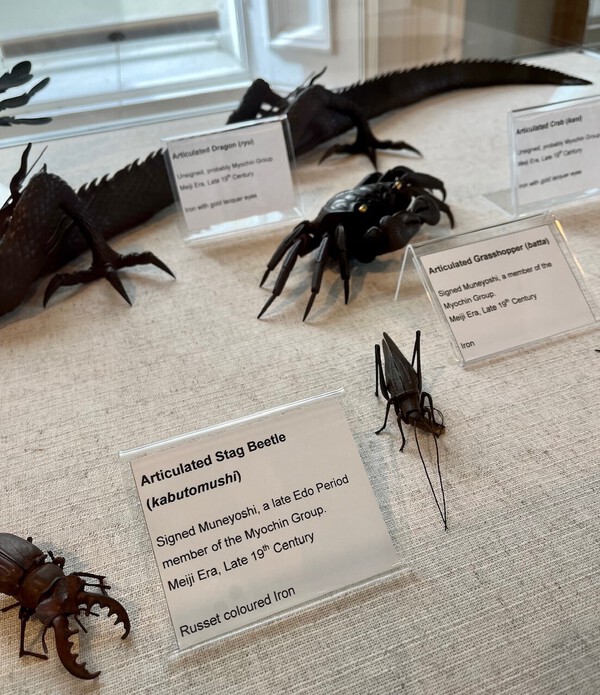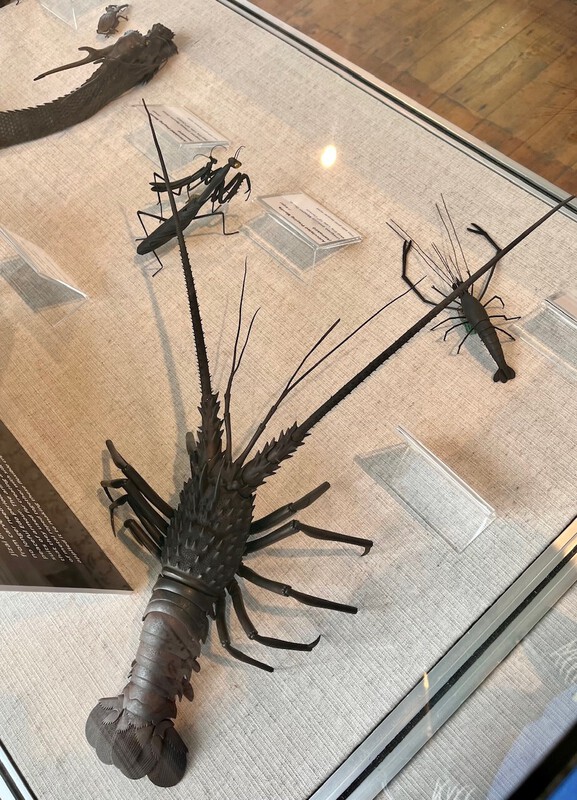-
Posts
14,000 -
Joined
-
Last visited
-
Days Won
255
Content Type
Profiles
Forums
Events
Store
Downloads
Gallery
Everything posted by Bugyotsuji
-
First of all thanks to all those who looked, especially to Brian for the honesty in his replies. Next, Colin has the correct answer. They are all fakes. Nos.1, 2, 4 and 5 are dark resin. No. 3 is a striped wood, possibly ebony (?). In the bottom row, No. 9 is resin and No. 10 is some kind of crudely-carved green soapstone. Nos. 6 & 7 are possibly boxwood, but you'll see tables covered in these. Their freshness and the identical beady black eyes give them away at once. No. 8, the egg-shaped Asterix-like warrior figure is also that same stripy ebony (?), and the himotoshi holes are up by his neck, in totally the wrong place. Of the two ebony figures, (3&9) the one carrying the sack has a signature plaque underneath which will fool a lot people. "If it's signed, it's surely got to be real." These shell cartouche signature plaques often look similar. The names are Japanese-looking signatures, scrawled for illegibility, and often dyed red. If a Netsuke is looking up at you and cute or smiling, it was probably carved appealingly for the post-Meiji Western tourist market. Most of the features above are immediate tell-tale warnings. (Unfortunately the forger's art progresses.) Apologies for the diversion. I kept a box of these NLO for just such an occasion, and felt a need to get this subject in the open and out of the way. (Photos supplied regarding any of the above points.) Please feel free to add to this thread for the benefit of us all!
-
isoroku イソロク is probably meant to refer to Yamamoto Isoroku, the famous admiral. The strange stencil writing on the handle says '10,000 year life'. 一万年の人生 Agreeing with Brian.
-
Gotta get back to work, but before my break ends here is a hint. Small button aside, how many are wood, how many are resin, and how many are stone? The answer may surprise some. The answer is that five are resin. Although there is evidence that forms of resin were used to make pressed Netsuke back in Meiji times, these examples above are all modern. Although they look like wood, they tend to be heavier, and close examination should reveal mould casting lines, and/or evidence of sanding to remove such lines. Resin Netsuke can be made by some museums too for sale in their shop, but underneath a flat filed bottom (and sometimes a logo mark or Romanized lettering) usually makes that clear. If five are resin, then we can say that at least five are fakes.
-
特製 Tokusei in Japan means 'specially made' and it looks typical to me. Perhaps someone here will recognize the logo mark of the workshop or factory?
-
Same here, so, one of the owners of what... one of the armours, or of Chiddingstone itself?
-
We are often forced into some kind of guessing game, looking behind the words. For example the attribution on your paperwork is Uda, but it does not say 'Den' Uda 伝宇多; in other words they are pretty sure it is an Uda blade. What is the meaning of DEN - Tosogu - Nihonto Message Board
-
I'm guessing not many have found this nook corner haven, so let's give it a full earth day. Top row, from left. 1. Horse grazing with bound legs, or emerging from gourd. 2. Horse lying with large fly on back. 3. Strange creature with stick, carrying sack. 4. Perching eagle. 5. Monkey with hands caught in jar. Bottom row. 6. Snail and frog kissing. 7. Octopus and monkey entwined. 8. Warrior with sword behind back. 9. See-no-evil seated monkey. 10. Speak-no-evil seated monkey. + small kagami-buta type manju button (behind octopus)
-
As Jean says, the whole thing is the complete address of the organization. Are you wanting this in Romanized form?
-
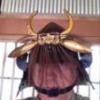
3 in one oil for nihonto ?
Bugyotsuji replied to Bosco's topic in General Nihonto Related Discussion
If there is no active rust already, no need to add or do anything. The oils from your fingers will help keep the Nakago black and stable. -

3 in one oil for nihonto ?
Bugyotsuji replied to Bosco's topic in General Nihonto Related Discussion
Of course there is some kind of 100% pure mineral oil that some Nihonto folks swear by. -
Conversely, a strange thing happened at a sword meeting about a year ago. I have a kozuka with a Sukekane Mei on the blade. I showed it to the sword Sensei, and without hesitation he said, "Yes, it's a genuine example of a Sukekane Mei". He had no doubt that it was made by (a) Bakumatsu Bizen Sukekane. Perhaps at that time there was no one faking Sukekane kozuka blades!?!? The exception proves the rule?
-

3 in one oil for nihonto ?
Bugyotsuji replied to Bosco's topic in General Nihonto Related Discussion
On the bottle it says “For the protection of high quality blades”. Camellia Oil for Blades -
Moriyama San, you have very good eyes!
-
And… by popular acclaim, here is our old favourite, the ‘Sharpen your Eyes’ corner. Can anyone spot the fake, and for bonus points, say why you think it is fake? (More than one answer possible.) PS Yes, without taking these in hand and examining them closely it is not an easy task. More photos available upon request.
-
Very similar in feeling! (Partly confirms a suspicion I had.) Nice find, Colin, thanks! (Do you have a photographic memory, by any chance, or was this just coincidence?)
-
Meantime, to kickstart this thread, here is a netsuke. It is quite representative of Netsuke in general, a little small perhaps, and the only reason I have chosen this one is that it is my latest find. (And I like it.) Unsigned, it is probably carved from 'tsuge' 柘植, 黄楊, 樿 etc., boxwood, for which there are various Kanji. Buxus microphylla var. Japonica. The carving is finely done, and the netsuke is a pleasure to hold in the hand. There are no added himotoshi holes, this netsuke taking advantage of the natural gaps between the stems of the mushroom branch through which to pass the strings. (Re Himotoshi. Himo 紐 means string/cord, and 通し toshi is part of the verb 通す tosu, to pass through. Short for himotoshi-ana, or 'string-threading holes'.) What would once have hung from this possibly seasonal Netsuke? Quite realistically carved, I can imagine that it might stimulate the taste buds of a Japanese person. Photos follow Can be enjoyed from any angle.
-
廣 Hiro… for the first character, I reckon.(?) PS Thanks for all the extra pics. It definitely helps!
-
At risk of going off-topic, Majus, Russ, I have some photos of Chiddingstone armour too. For example:
-
Majus, apologies for the poor photo quality and reflections. (As I was trying to get around the glass cases for a better angle I must have set off the motion sensors!)
-
There are some really very good jizaimono in Chiddingstone Castle in Kent. If I can find a photo or two... (And Kevin Page in London has some amazing ones too.) And Also
-
That looks like his thatched cabin, which must also act as a hide. I've seen thatched-roof boats on the lake in Korakuen.
-
Getting water to make tea, or cook rice?
-
+清 方清 Hosei or Katakiyo generally, but as a smith, to be read Nio Masakiyo.(?) https://asiaartgallery.jp/category/touken/results/005/
-
Totally agree they bear little resemblance, and it is hard to imagine the same person being able to write in differing calligraphy quite so schizophrenically. After searching several Kuzushiji websites, I have given up on this, although your original guess for 津 could still be correct. Perhaps one of our esteemed NMB guardian gatekeepers could step in and sort this out?
-
Motte sabinai tetsu saku kore Kanenaga Kanenaga made this from stainless steel. (On the wood habaki it also seems to say Kanenaga)(?)
- 1 reply
-
- 6
-





